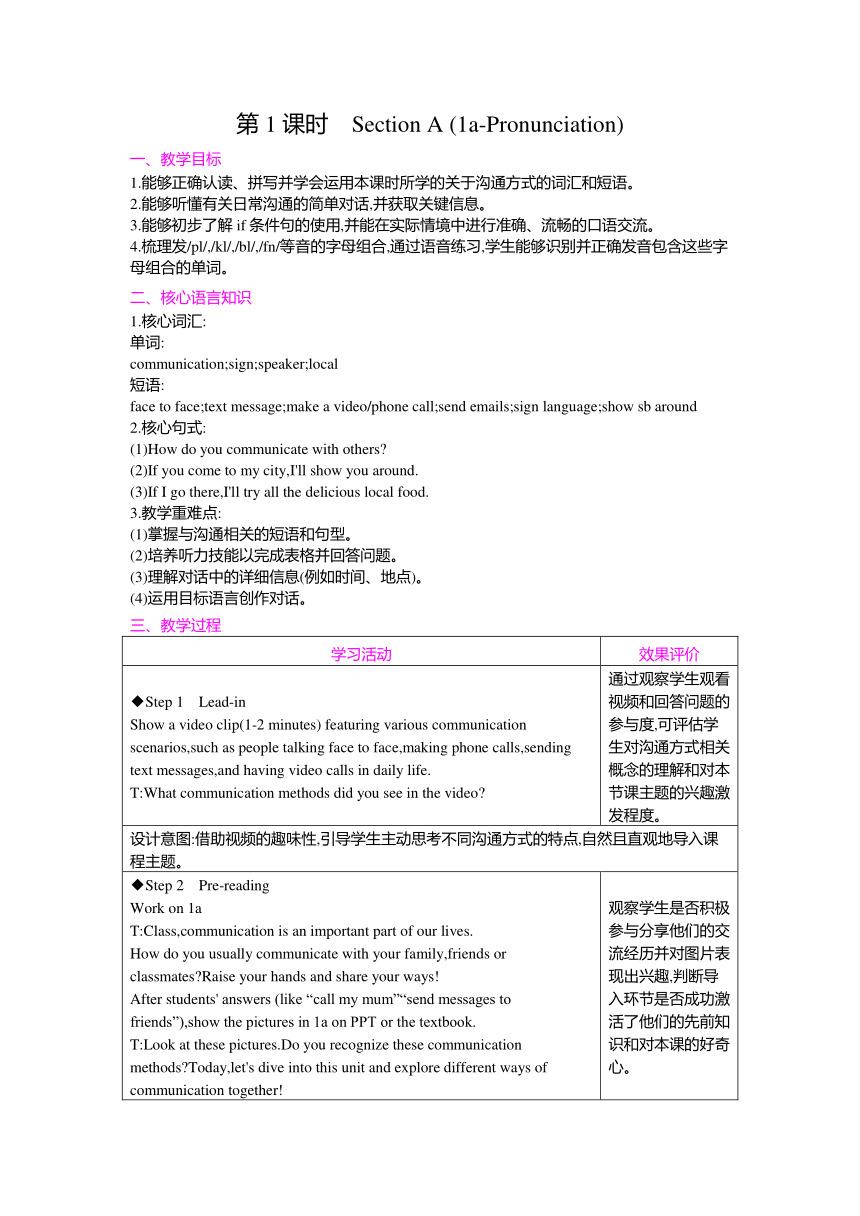Unit 8 Let's Communicate! 第1课时 Section A (1a-Pronunciation)教案人教版(2024)八年级上册
文档属性
| 名称 | Unit 8 Let's Communicate! 第1课时 Section A (1a-Pronunciation)教案人教版(2024)八年级上册 |  | |
| 格式 | docx | ||
| 文件大小 | 17.0KB | ||
| 资源类型 | 教案 | ||
| 版本资源 | 人教版 | ||
| 科目 | 英语 | ||
| 更新时间 | 2025-07-13 16:55:56 | ||
图片预览

文档简介
第1课时 Section A (1a-Pronunciation)
一、教学目标
1.能够正确认读、拼写并学会运用本课时所学的关于沟通方式的词汇和短语。
2.能够听懂有关日常沟通的简单对话,并获取关键信息。
3.能够初步了解if条件句的使用,并能在实际情境中进行准确、流畅的口语交流。
4.梳理发/pl/,/kl/,/bl/,/fn/等音的字母组合,通过语音练习,学生能够识别并正确发音包含这些字母组合的单词。
二、核心语言知识
1.核心词汇:
单词:
communication;sign;speaker;local
短语:
face to face;text message;make a video/phone call;send emails;sign language;show sb around
2.核心句式:
(1)How do you communicate with others
(2)If you come to my city,I'll show you around.
(3)If I go there,I'll try all the delicious local food.
3.教学重难点:
(1)掌握与沟通相关的短语和句型。
(2)培养听力技能以完成表格并回答问题。
(3)理解对话中的详细信息(例如时间、地点)。
(4)运用目标语言创作对话。
三、教学过程
学习活动 效果评价
◆Step 1 Lead-in Show a video clip(1-2 minutes) featuring various communication scenarios,such as people talking face to face,making phone calls,sending text messages,and having video calls in daily life. T:What communication methods did you see in the video 通过观察学生观看视频和回答问题的参与度,可评估学生对沟通方式相关概念的理解和对本节课主题的兴趣激发程度。
设计意图:借助视频的趣味性,引导学生主动思考不同沟通方式的特点,自然且直观地导入课程主题。
◆Step 2 Pre-reading Work on 1a T:Class,communication is an important part of our lives. How do you usually communicate with your family,friends or classmates Raise your hands and share your ways! After students' answers (like “call my mum”“send messages to friends”),show the pictures in 1a on PPT or the textbook. T:Look at these pictures.Do you recognize these communication methods Today,let's dive into this unit and explore different ways of communication together! 观察学生是否积极参与分享他们的交流经历并对图片表现出兴趣,判断导入环节是否成功激活了他们的先前知识和对本课的好奇心。
设计意图:通过提问与学生的日常生活相关的问题,激发他们的表达欲望并顺利引入主题。同时,图片为1a中的词汇匹配任务奠定视觉基础。
◆Step 3 While-listening 1.Work on 1b Listening for Main Information (1b) Play the recording for 1b.Ask students to complete the table about “How the speakers communicate” and “Their relationship”.Check answers and explain unclear points. 2.Work on 1c Listening for Details (1c) Play the recording again for 1c.Students answer questions about time,place,and actions.Discuss answers,and emphasize listening for specific details (e.g.numbers,places). 通过观察学生填表情况和回答问题准确率,给予针对性指导,确保学生掌握关键信息获取技巧。
设计意图:通过提前引导学生明确听力任务,让学生有目的地去听,培养其听力前的预判能力。多次播放听力材料,给予学生充分捕捉信息的机会,锻炼其信息记录与整合能力。
◆Step 4 Role-play Work on 1d 1.Students work in groups to role-play the conversations. 2.Explain “if” sentences (e.g.correct tense matching:If+present simple,will+verb 原形). 3.Divide students into groups of 4.Provide themes like “inviting a foreign friend to your hometown” or “planning a class party”.Require groups to create a dialogue using “if” conditional sentences (e.g.If you come to my hometown,I'll take you to try local snacks;If we hold a party,we'll need to prepare decorations). Each group performs the dialogue. 通过观察学生对话的流畅度、语言表达的准确性和创意性,给予反馈和指导,确保学生能够运用所学语言进行实际交流。
设计意图:通过角色扮演活动,激发学生的创造力和语言运用能力,帮助他们在真实情境中练习口语表达,同时加深对文化背景的理解。
◆Step 5 Pronunciation Work on Pronunciation 1 and 2 通过观察学生跟读、比赛表现及朗读标记情况,给予针对性反馈,确保学生掌握正确的发音规则和语音技巧。
设计意图:通过跟读、比赛和对比练习,帮助学生掌握字母组合的发音规则,提升连读、重音、语调和停顿的运用能力,使英语表达更加自然流畅。
板书设计 Unit 8 Let's Communicate! 第1课时 Section A (1a-Pronunciation) 一、Key Phrases:talk face to face;send text messages;make a video call;use sign language 二、Key Sentences:Can you pick me up at… If you come to…,I'll… 三、Pronunciation
课堂评价
作业布置
必做: 1.Carefully copy the phrases about communication methods in 1a of this class period.Copy each phrase five times and recite them at the same time. 2.According to the situations in part 1d of the textbook,select an situation,create a new dialogue with your partner,and record the content of the dialogue to share in the next class. 选做: Interview classmates about their favourite communication methods and make a report.
教学反思
本次教学围绕 “沟通方式” 展开,设计听前、听中、听后环节,旨在培养学生语言知识与技能。实施过程中,亮点如下:导入环节通过视频或话题讨论,激活学生生活经验,快速聚焦主题;听前词汇铺垫扎实,降低听力理解难度;听中活动分层设计,从整体信息抓取到细节捕捉,逐步提升听力策略;听后小组对话创作,推动 “if” 条件句的实践运用,促进知识转化。分层作业也兼顾了不同学生的学习需求。 但仍存在改进空间:小组活动中,部分学生参与不均衡,出现 “少数主导、多数旁观” 现象;听力细节理解环节,部分学生对时间、地点等关键信息捕捉不准,暴露出听力技巧指导的不足。
一、教学目标
1.能够正确认读、拼写并学会运用本课时所学的关于沟通方式的词汇和短语。
2.能够听懂有关日常沟通的简单对话,并获取关键信息。
3.能够初步了解if条件句的使用,并能在实际情境中进行准确、流畅的口语交流。
4.梳理发/pl/,/kl/,/bl/,/fn/等音的字母组合,通过语音练习,学生能够识别并正确发音包含这些字母组合的单词。
二、核心语言知识
1.核心词汇:
单词:
communication;sign;speaker;local
短语:
face to face;text message;make a video/phone call;send emails;sign language;show sb around
2.核心句式:
(1)How do you communicate with others
(2)If you come to my city,I'll show you around.
(3)If I go there,I'll try all the delicious local food.
3.教学重难点:
(1)掌握与沟通相关的短语和句型。
(2)培养听力技能以完成表格并回答问题。
(3)理解对话中的详细信息(例如时间、地点)。
(4)运用目标语言创作对话。
三、教学过程
学习活动 效果评价
◆Step 1 Lead-in Show a video clip(1-2 minutes) featuring various communication scenarios,such as people talking face to face,making phone calls,sending text messages,and having video calls in daily life. T:What communication methods did you see in the video 通过观察学生观看视频和回答问题的参与度,可评估学生对沟通方式相关概念的理解和对本节课主题的兴趣激发程度。
设计意图:借助视频的趣味性,引导学生主动思考不同沟通方式的特点,自然且直观地导入课程主题。
◆Step 2 Pre-reading Work on 1a T:Class,communication is an important part of our lives. How do you usually communicate with your family,friends or classmates Raise your hands and share your ways! After students' answers (like “call my mum”“send messages to friends”),show the pictures in 1a on PPT or the textbook. T:Look at these pictures.Do you recognize these communication methods Today,let's dive into this unit and explore different ways of communication together! 观察学生是否积极参与分享他们的交流经历并对图片表现出兴趣,判断导入环节是否成功激活了他们的先前知识和对本课的好奇心。
设计意图:通过提问与学生的日常生活相关的问题,激发他们的表达欲望并顺利引入主题。同时,图片为1a中的词汇匹配任务奠定视觉基础。
◆Step 3 While-listening 1.Work on 1b Listening for Main Information (1b) Play the recording for 1b.Ask students to complete the table about “How the speakers communicate” and “Their relationship”.Check answers and explain unclear points. 2.Work on 1c Listening for Details (1c) Play the recording again for 1c.Students answer questions about time,place,and actions.Discuss answers,and emphasize listening for specific details (e.g.numbers,places). 通过观察学生填表情况和回答问题准确率,给予针对性指导,确保学生掌握关键信息获取技巧。
设计意图:通过提前引导学生明确听力任务,让学生有目的地去听,培养其听力前的预判能力。多次播放听力材料,给予学生充分捕捉信息的机会,锻炼其信息记录与整合能力。
◆Step 4 Role-play Work on 1d 1.Students work in groups to role-play the conversations. 2.Explain “if” sentences (e.g.correct tense matching:If+present simple,will+verb 原形). 3.Divide students into groups of 4.Provide themes like “inviting a foreign friend to your hometown” or “planning a class party”.Require groups to create a dialogue using “if” conditional sentences (e.g.If you come to my hometown,I'll take you to try local snacks;If we hold a party,we'll need to prepare decorations). Each group performs the dialogue. 通过观察学生对话的流畅度、语言表达的准确性和创意性,给予反馈和指导,确保学生能够运用所学语言进行实际交流。
设计意图:通过角色扮演活动,激发学生的创造力和语言运用能力,帮助他们在真实情境中练习口语表达,同时加深对文化背景的理解。
◆Step 5 Pronunciation Work on Pronunciation 1 and 2 通过观察学生跟读、比赛表现及朗读标记情况,给予针对性反馈,确保学生掌握正确的发音规则和语音技巧。
设计意图:通过跟读、比赛和对比练习,帮助学生掌握字母组合的发音规则,提升连读、重音、语调和停顿的运用能力,使英语表达更加自然流畅。
板书设计 Unit 8 Let's Communicate! 第1课时 Section A (1a-Pronunciation) 一、Key Phrases:talk face to face;send text messages;make a video call;use sign language 二、Key Sentences:Can you pick me up at… If you come to…,I'll… 三、Pronunciation
课堂评价
作业布置
必做: 1.Carefully copy the phrases about communication methods in 1a of this class period.Copy each phrase five times and recite them at the same time. 2.According to the situations in part 1d of the textbook,select an situation,create a new dialogue with your partner,and record the content of the dialogue to share in the next class. 选做: Interview classmates about their favourite communication methods and make a report.
教学反思
本次教学围绕 “沟通方式” 展开,设计听前、听中、听后环节,旨在培养学生语言知识与技能。实施过程中,亮点如下:导入环节通过视频或话题讨论,激活学生生活经验,快速聚焦主题;听前词汇铺垫扎实,降低听力理解难度;听中活动分层设计,从整体信息抓取到细节捕捉,逐步提升听力策略;听后小组对话创作,推动 “if” 条件句的实践运用,促进知识转化。分层作业也兼顾了不同学生的学习需求。 但仍存在改进空间:小组活动中,部分学生参与不均衡,出现 “少数主导、多数旁观” 现象;听力细节理解环节,部分学生对时间、地点等关键信息捕捉不准,暴露出听力技巧指导的不足。
同课章节目录
